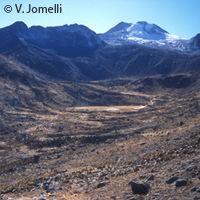Scientists unearth cause of tropical glacier melt
Researchers from France and the United States have successfully uncovered the mystery of what caused tropical glaciers to melt over the last 10,000 years. Presented in the journal Nature, the study was funded in part by the MOTIF ('Models and observations to test climate feedbacks') project, which clinched more than EUR 181,000 under the 'Energy, environment and sustainable development' (EESD) Thematic programme of the EU's Fifth Framework Programme (FP5). Experts from the France-based Centre National de la Recherche Scientifique (CNRS), the Commissariat à l'énergie atomique et aux energies alternative (CEA), the Institut de recherche pour le développement (IRD) and the Université Joseph Fourrier, in cooperation with a colleague from the University of Albany in the United States, discovered that the retreat of the Telata glacier in Cordillera Real, a mountain range in the South American Altiplano of Bolivia, is largely linked to the warming of the tropical Pacific Ocean and a 3°Celsius increase in air temperature. Tropical glaciers are primarily found in the Andes, and researchers say one must understand their recent history in order to determine why they retreated. The Telata moraines, rocks deposited by the glacier marking its earlier positions, make this a special site in tropical regions due to their unbroken record of successive glacial stages, according to the team. They carefully mapped 57 Telata moraines, measuring the concentration of elements in the rocks. The team reconstructed the glacier's history during the Holocene period, thus covering a 10,000-year span. Illustrating how the warming and air temperature rise impacted the glacier's retreat, the team investigated the potential link between the glacial volume and the prevailing temperature and precipitation values for various positions of the glacier in the past. Their data show that the glacier's surface area shrank during this period. The front of the glacier also retreated by three kilometres. The researchers note that the glacial retreat has picked up speed since the start of the 19th century, in contrast to its a slow start. More specifically, they say that it has retreated by 2 kilometres since 1820. Based on their measurements, the retreat of the glacier was triggered by the 3.3°C increase over the entire Holocene. The tropical Pacific Ocean's surface temperature and the climate in the area of the glacier were influenced by the increase in solar radiation at the surface of the planet. So the temperature rise changed the glacier's behaviour, leading to its retreat. By performing numerical simulations with climate models, researchers found differences in precipitation over the last 10,000 years. This research study was the first of its kind to substantiate a link between variations in surface temperatures of the tropical Pacific Ocean, confirming the extraordinary nature of the rapid melting seen since the industrial revolution. The researchers say these tropical glaciers will be very vulnerable during the projected warming of the 21st century in the Telata region.For more information, please visit: CNRS: http://www.cnrs.fr/ Nature: http://www.nature.com/
Countries
France, United States

